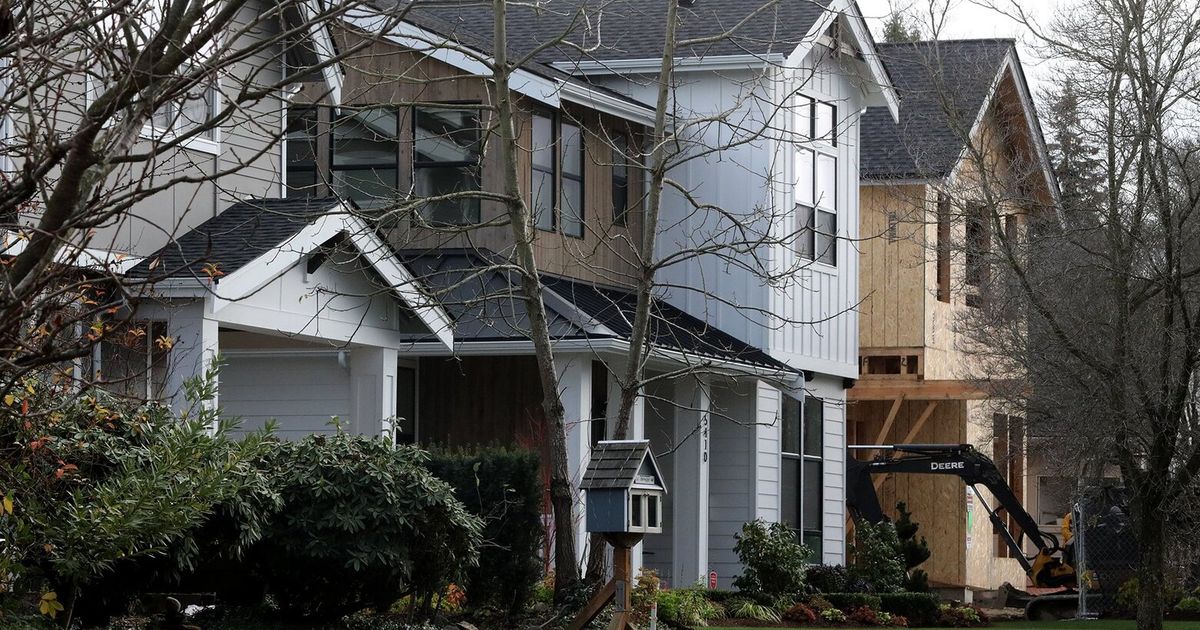High interest rates are making a tough housing market even tougher.
Seattle-area homebuyers, especially those looking for their first house, are feeling the pressure of soaring interest rates on top of already-high prices.
Despite a slight dip, the average rate for a 30-year fixed-rate mortgage hovered at nearly 6.7% this week, about twice the rate at the start of the year. And while the housing market is cooling off, buyers say home prices haven’t fallen enough to feel like they can afford the interest rates.
The result: “We are just kind of holding off,” said Danielle Crawford, who is looking to buy a home in Puyallup. Crawford hopes that prices will drop a bit more or that the interest rate will come down.
“I don’t know that either one of those things is going to be happening any time soon,” Crawford said.
High mortgage rates are sidelining buyers like Crawford and decreasing the heated competition that fueled the local housing market for the last two years. That has led to a cooldown: fewer people are buying houses and prices in King County dropped 12.4% since this spring.
Yet, affording a home is still a challenge.
The median single-family home in King County sold for $875,000 in September, up 6% from a year ago, according to new data released Thursday by the Northwest Multiple Listing Service.
Median prices were $538,000 in Pierce County, $735,000 in Snohomish County and $539,997 in Kitsap County.
Prices in all four counties ticked down 2-3% from August and were up 6-9% from last year. At this time last year, prices were up between 10% and 19% year over year. This April, King County prices were up nearly 20% from a year earlier.
In the Puget Sound region, twice as many homes were sitting on the market at the end of September as at the same time last year.
Still, the market is not balanced by industry standards. It would take about two months to sell all the single-family homes for sale in King County at the current demand, according to a measure known as months of inventory. The listing service considers four to six months a balanced market, a level the market hasn’t seen in at least six years.
Crawford and her husband struggled to compete in the frenzied market of the last few years, so they waited to buy, she said. But once they began their search, interest rates were chipping away at their buying power.
The family is hoping to find a three-bedroom home with room in the yard for a swingset for their twin boys, and they don’t want to exceed a monthly payment of $2,600. That put their budget at around $375,000. Finding homes at that price point has been “incredibly difficult,” Crawford said.
The median home price in the Puyallup area last month was $539,500, up 5.7% from last year.
“Although the interest rate has gone up significantly, the home prices have only come down a little bit, so that changes everything for us,” Crawford said.
The family can stretch its budget, she said, but “we still have to buy food. We still have to pay for day care.”
Buyers all over the country are facing similar obstacles. Nationally, the typical monthly mortgage payment on a new home was up 83% in August from the same time in 2019, according to Zillow. If rates hit 7%, the monthly payment would be $4,035 on a typical home in the Seattle area, which includes King, Piece and Snohomish counties in Zillow’s analysis.
First-time buyers are hardest hit by the rate hikes, said Keller Williams agent Bobby Brown.
“They don’t have a great deal of savings or a lot of flexibility to be able to go from wanting to buy a $500,000 house to a $600,000 house,” Brown said.
A percentage point increase can reduce a home shopper’s buying power by around 10%. “That’s significant to all of those people who were a month ago on the edge,” Brown said.
While shopping for a home in Rainier Beach, John Flodin watched the loan amount he qualified for drop from $500,000 to $425,000 over the course of a few weeks as interest rates climbed. That made an already difficult search for a starter home even harder.
Hoping to buy a single-family home in order to build equity for retirement, Flodin has run into a slim supply of listings in his price range.
He is now looking farther out, in Kitsap County, SeaTac, Burien and Des Moines.
Median home prices were up 6.9% in September from a year ago in Southwest King County, including areas such as Federal Way, Burien and Des Moines. Prices were up 5.9% in Seattle and 3% on the Eastside.
“Last year, I was really kind of thinking this was my opportunity. And now I’m really feeling somewhat hopeless,” Flodin said.
Flodin thought about tapping into his 401(k), but that fund is already suffering from the stock market downturn. With a good salary, decent credit and about a 5% down payment, Flodin knows others are squeezed even more.
“If this is the kind of experience somebody like myself is having, there are a lot of other people in this city, in this region that are going to be unable to make this work, ever,” Flodin said.
For buyers wondering whether rates might decline, allowing them to agree to a higher rate now and refinance, Brown urges caution. “You have to be able to weather the storm,” he said, warning that lower rates might not be on the horizon soon.
In a news release from the listing service, Windermere Chief Economist Matthew Gardner predicts home prices will remain up year over year until the spring, when they will “start to trend negative” for “a short period of correction.”
Some buyers are finding the upside of the current market.
A seller recently accepted Air Force veteran Kevin Colewell’s offer on a house near Spanaway and agreed to pay closing costs, he said. “The tables have turned and now it’s beneficial for people who qualify for a VA loan to get out there and look for a house they want,” Colewell said.
Sellers are adjusting their prices and negotiating with buyers. Others are putting off listing their homes for sale, brokers say.
If more sellers decide to hold off, it could exacerbate the region’s tight housing inventory, said Wendy Carrington, a John L. Scott agent in Seattle.
“We just have such a scarcity of supply overall,” Carrington said, “and we already had that issue before these other factors.”
















